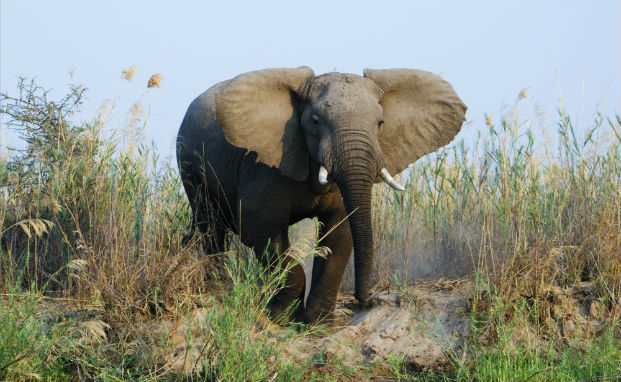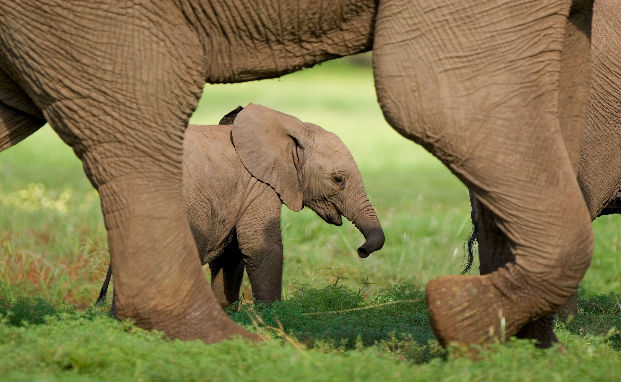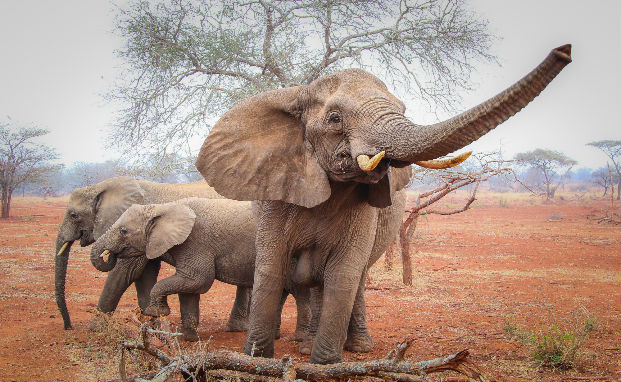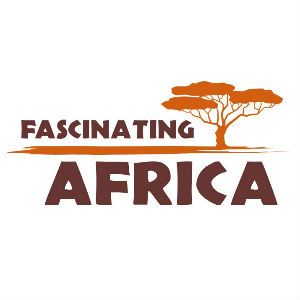Jomi Krobb writes about the, sometimes scary, experiences that he has had with elephants on the Makuleke concession. There is a lot to ponder, especially the reasons why the elephants may behave in the way that they do.
James asked me to write a guest blog for him, actually, he has urged me to for a while now and I initially agreed to do it but am now finally getting around to it.
My use of imagery and metaphors certainly are probably nowhere near the poetic standard of James’ normal posts but sit tight. (I do know how to spell the place and people-names though.)
I guess to begin with we should go back a week and a half to last weekend. I had been guiding at the Outpost lodge for a couple of nights. This makes for not only an interesting change of scenery from the usual Ecotraining set-up but also gives me the chance to earn some pocket money. I had three sets of guests over those few days and had taken them, or, in the case of one couple, persuaded them rather to come on a bush walk with me.
A momentous occasion as it was the first time I was leading proper guests without any sort of mentor there to have my back should anything go wrong. Luckily it didn’t, the walk turned out to be reasonably eventless apart from one of the guests tripping over a log and face-planting himself. But it was just the type of walk I needed to ‘begin’ my trails career and the guests enjoyed every moment of the fever trees. No sign of elephant.
The elephant is one of the Big Five. To find out the other four animals that make up the Big Five please check out our article: 25 astonishing facts about Africa’s Big 5
On the following morning only one set of guests came out. The winter mornings are cold and ultimately these people are here for a relaxing holiday so I could understand that they weren’t too keen on braving the cold. The couple in question were keen birders, which I was only too happy about so we set out for Banyini; a birder’s wet dream.
We were driving down Outpost Home Run when I saw an elephant ahead. It was only one animal but some sixth sense told me to slow down and stop at a healthy distance; perhaps it’s because the Outpost guides frequently call in breeding herds on the Home Run. I turned out to be correct and after inching forward could here branches breaking all around. We were already in the middle of the herd. I tentatively switched off the engine in order to hear them properly. The guest were enjoying themselves despite the bitter cold as I interpreted some casual displacement behaviour of a youngish bull.
A couple of adult cows and some very young calves wandered across the road about 50 metres ahead. I could tell the female, possibly the matriarch wasn’t happy. Head held high and tail sticking straight out she shielded the young ones as she presented herself laterally across the road and waited for them to cross safely. That little group disappeared but we continued to listen. I wasn’t ready to move on just yet. A couple of minutes later the same group crossed again, the old female appeared to be a bit more distressed , something to never take for granted, but given their distance I was not too worried. I waited a short while again and decided it was safe to move on. As I switched on the engine I could hear a big tree breaking in the direction the group of elephants had been heading. And then I could hear her, a juggernaut breaking through the thicket and running in a straight line towards the vehicle.
Whether or not she would have stopped in time I’ll never know but she had her head down and she was running at an alarming pace. I decided not to hold my ground for a change, put the car in reverse and drove back up the road towards the Outpost. She kept on coming for us, only giving up after about 100 metres. It’s remarkable how my reversing skills improved with adrenaline pumping through my body. The guests were South Africans and they played it very cool but I could tell they were shaken – I certainly was. The rest of the morning went by without event but clearly the story spread at breakfast. It seems the first thing people said to me the rest of that day was: ‘I HEARD about YOUR morning!’
What have we done to these animals in the past for them to react to us in such an antagonising way?
To give another brief example of how elephants react to humans up here: we were on a walk across the flood plain and had bumped a breeding herd that were busy feeding or bathing themselves in a little pool in the middle of the long grass. We decided to carry on north of them, at the edge of the fever trees and inevitably the wind changed. At this stage the elephants had begun moving parallel to us but as soon as they caught our scent the herd mobilised. What was a peaceful-looking scattered group of giants turned into a tight, organised unit within seconds. We quickly moved behind a bush for cover. The herd was heading straight in our direction. Some of the students thought the elephants were charging us; it certainly appeared that way but it turned out to be nothing but a coordinated run for cover, which happened to be the fever trees, where we were. Almost as soon as the herd hit the fever trees they dispersed again.
This was another indication that these animals will avoid confrontation with us as much as possible. Perhaps behaviour like this has been misinterpreted in past cases as ‘aggression.’ On this day it was certainly brilliant to have Alan with us, there is no one I have seen in the past year who can read elephants and their behaviour like he does and most other guides would have either acted aggressively towards the animals or not stood their ground at all. But it was merely our scent which triggered this instantaneous behaviour amongst the eles. WHY?
It is something that has fascinated me during my time in Makuleke. Why are a lot of these elephants so skittish and afraid of us? Here are a few of my theories.
For one the elephants in the far northern Kruger are certainly not nearly as habituated as the ones in the south. There are far fewer people in cars and camps up here and the northern sector is not nearly as commercial as the southern part and adjacent private reserves. So a lack of contact means that these elephants follow their instinct to be afraid of man, the hunter.
The elephants do cross into Zimbabwe frequently (something James and I witnessed a couple of weeks back) and local guides and people I have spoken to seem to think that they get both hunted and chased out of local villages in the mystically corrupt land across the Limpopo. Indeed the drums and music we hear in Zim sometimes are apparently being played in order to deter the elephants.
I believe elephants to be very intelligent animals. After all ‘an elephant never forgets.’
Historically the area that we traverse on a daily basis is one that was hunted for decades, maybe even centuries. And when I say hunted I do not mean the subsistence poaching that occurs today and has occurred for thousands of years. I mean the strategic killing of elephants for their tusks. This lead to a section of the area being known as the Ivory Trail, where people such as Cecil ‘Bvekenya’ Barnard amongst many others made their trade in the late 19th and early 20th century. Bvekenya himself is accredited with killing over 300 elephants and that in such a small area. I do not believe that the elephant population will forget this any time soon even if these events occurred over 100 years ago. And without being too radical let’s compare this to other genocides such as the Apocalypse in Hitler’s Third Reich. No one will forget that any time soon.
The Ivory Poaching surely left the elephant population on the brink of extinction here if not under sever threat. While the population has recovered significantly there are constant reminders that elephant poaching is still a serious issue: a month and a half ago: an elephant was found poached in the Pafuri region; the first for over 20 years. What right does anyone have to let alone trespass on and invade these animals’ Home Ranges but furthermore kill them for profit. The thought sickens me. Stronger conservation measures need to be enforced and corruption amongst anti-poachers must end.
I want to end on a more positive note by saying that it is possible for us to co-exist with these wild/unhabituated animals. One of the best examples is our Ecotraining camp here at Makuleke, where the elephants frequently come into the camp to feed as they have gotten used to the structures and our presence here. Yet they are still shy when it comes to people and human contact. And that is the way it should be.
Discover more
Interested in doing a safari course yourself? Then visit the Courses and Events page where there are many to choose from. Courses range in length from one week to the eleven month professional safari guide course which Ulrica completed.
To really get to know what the professional safari course is like then read Safari School, it’s a daily diary of James’s experience of the course.
The magical wetlands of Makuleke




 Previous Post
Previous Post
